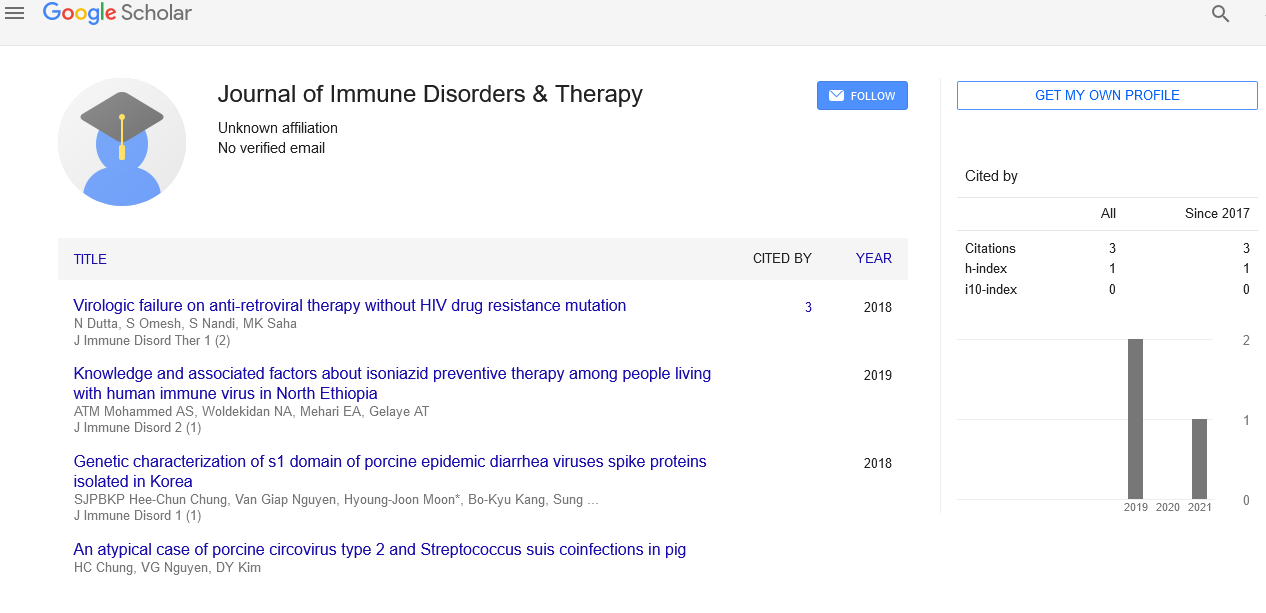Human endogenous retroviruses and autoimmunity: Towards a HERV Based therapy?
Received: 31-Oct-2017 Accepted Date: Oct 31, 2017; Published: 06-Nov-2017
Citation: Grandi N. Human endogenous retroviruses and autoimmunity: Towards a HERV-Based therapy? J Immune Disord Ther. November-2017;1(1):8-9.
This open-access article is distributed under the terms of the Creative Commons Attribution Non-Commercial License (CC BY-NC) (http://creativecommons.org/licenses/by-nc/4.0/), which permits reuse, distribution and reproduction of the article, provided that the original work is properly cited and the reuse is restricted to noncommercial purposes. For commercial reuse, contact reprints@pulsus.com
Description
Human Endogenous Retroviruses (HERVs) are relics of ancestral infections that affected primates’ germ line cells over the last 100 millions of years. The subsequent vertical transmission through the offspring made these sequences a major structural contributor to the host DNA, constituting nowadays about the 8% of human genetic material [1]. The endogenization process led, moreover, to the acquisition of important host physiological functions; given that multiple HERV-derived proteins have been domesticated for placenta development and homeostasis [2-4]. In addition, (H) ERVs had also a major role in the evolution of the hosts’ defenses, contributing to the shaping of the interferon system, a pivotal effector of innate immunity [5].
Independent ERVs integrations, in fact, sustained the expansion of such an important regulatory network in different mammalian lineages, by the spreading of interferon-inducible genes that have been occasionally coopted for immune regulation purposes [5]. Due to the fact that HERVs are stable components of primates’ genome, an immune tolerance to their expressed products should theoretically have been established during development.
Contrarily, HERV proteins still show the capacity to evoke both innate and adaptive immunity, being thus widely investigated for their possible role in a number of autoimmune disorders [6,7]. HERV-derived antigens and/or specific antibodies directed against them have in fact been detected in patients with autoimmune disorders as compared to healthy individuals [6]. Such immunogenic effect is thought to rely, at least in part, on the molecular mimicry between HERV products and exogenous viral pathogen associated molecular patterns, leading to the stimulation of cellular pattern recognition receptors and the onset of autoimmune reactions [6]. A consistent amount of evidences supported the significant presence of HERV antigens in a number of diseases, such as multiple sclerosis (MS), diabetes, rheumatoid arthritis and lupus [6].
However, in general, both the lack of identification of the specific HERV loci involved and the presence of a complex and poorly understood etiology prevented, until now, the definitive association of HERVs to any autoimmune disorder [8]. While it is unlikely that HERVs expression can itself trigger the disease onset, current evidences strongly suggest that their related immunogenic properties can participate to autoimmunity development, being even major determinants of its clinical manifestations.
As an example, an HERV-W derived Envelope protein was shown to be significantly present in MS active lesions, triggering specific humoral responses as well as acting as super-antigen in the nonspecific polyclonal stimulation of auto-reactive T lymphocytes [8]. Consistently, this HERV protein promoted the development of experimental allergic encephalomyelitis in mice [9] and a monoclonal antibody directed against it is currently in clinical development as MS therapeutic agent, representing the first HERV-based pharmacological approach for a human illness [10].
Overall, it is certainly likely that specific HERV sequences and their products may play an important role in autoimmunity, even without necessarily being the sole aetiological determinant. Indeed, it is probable that one or more HERV loci (or even some specific allelic variants) may participate in a complex interplay with other poorly understood co-factors, involving the host genetic predisposition in concert with behavioral and environmental triggers. The assessment of such an intriguing scenario must however rely on a stringent methodological approach, able to identify the specific HERV sequences differentially or selectively expressed in a given pathological condition and to characterize their molecular mechanisms of pathogenesis. In such a way, HERV- derived antigens would provide a potential and still unexplored source of both specific biomarkers, when expressed selectively in diseased tissues, and innovative therapeutic targets, if actively contributing to autoimmunity clinical manifestations.
REFERENCES
- Vargiu L, Rodriguez-Tomé P, Sperber GO, et al. Classification and characterization of human endogenous retroviruses mosaic forms are common. Retrovirology 2016;13:7
- Blond JL, Lavillette D, Cheynet V, et al. An envelope glycoprotein of the human endogenous retrovirus HERV-W is expressed in the human placenta and fuses cells expressing the type D mammalian retrovirus receptor. J Virol 2000;74(7):3321-9.
- Mi S, Lee X, Li X, et al. Syncytin is a captive retroviral envelope protein involved. Nature 2000;403(6771):785-89.
- Blaise S, de Parseval N, Bénit L, et al. Genomewide screening for fusogenic human endogenous retrovirus envelopes identifies syncytin 2, a gene conserved on primate evolution. Proc Natl Acad Sci U S A 2003;100(22):13013-18.
- Chuong EB, Elde NC, Feschotte C. Regulatory evolution of innate immunity through co- option of endogenous retroviruses. Science 2016;35(6277):1083-87.
- Trela M, Nelson PN, Rylance PB.The role of molecular mimicry and other factors in the association of human endogenous retroviruses and autoimmunity. APMIS 2016;124(1-2):88-104.
- Hurst TP, Magiorkinis G. Activation of the innate immune response by endogenous retroviruses. J Gen Virol 2015;96(6):1207-18.
- Grandi N, Tramontano E. Type W human endogenous retrovirus (HERV-W) integrations and their mobilization by L1 machinery: Contribution to the human transcriptome and impact on the host physiopathology. Viruses 2017;9(7):162.
- Perron H, Dougier-Reynaud HL, Lomparski C, et al. Human endogenous retrovirus protein activates innate immunity and promotes experimental allergic encephalomyelitis in mice. PLoS one 2013;8(12):e80128.
- Curtin F, Perron H, Faucard R, et al. Treatment against human endogenous retrovirus: A Possible Personalized Medicine Approach for Multiple Sclerosis. Mol Diagn Ther 2015;19(5):255-65.





